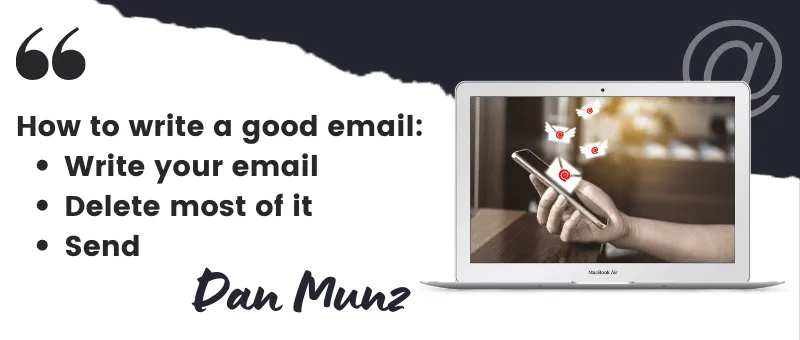Email marketing can be a powerful tool for building relationships with your audience and driving sales. But let’s face it, most people get far too many emails in their inbox every day, and they don’t have time for everything. So how do you keep people engaged on your email list without boring them to death?
First things first, let’s remember that there are real people on the other end of those email addresses. So, when you’re crafting your messages, keep in mind that you’re communicating with human beings who want to hear from you.
Here are some tips:
1. Keep it Short and Sweet
Nobody wants to read a novel in their email inbox. Keep your emails short and to the point. If you have a lot of information to share, break it up into smaller, bite-sized chunks and send it out over a series of emails.
Of course, this is entirely dependent on your audience. Some life coaches, consultants and even marketers have readers who enjoy very long emails, but most people do not.
Example: “Howdy! Just wanted to let you know that our spring sale is here, and you can save 20% on everything in-store and online. Get in quick, as the sale ends soon. Happy shopping!”
2. Make it Interesting
Your emails should be interesting and engaging. Use catchy headlines, colorful images, and interesting stories to capture your reader’s attention. Think about what would make you want to open and read an email, and use that to guide your content.
Example: “Do you know what’s even better than coffee? FREE coffee! And we’re offering just that to our email subscribers this month. All you have to do is show this email to our barista, and you’ll get a complimentary cup of joe. Trust us; your taste buds will thank you!”
3. Personalize Your Emails
People are more likely to engage with content that feels personal and relevant to them. Use their first name in the email greeting, and tailor your content to their interests and needs. You can do this by segmenting your email list based on demographics or past behaviors, such as previous purchases or email opens.
Example: “Hey [insert first name], we noticed that you’re a fan of our organic skincare range. Well, we’ve got some exciting news for you – we’ve just released a brand-new product that we think you’ll love. Check it out and let us know what you think!”
4. Offer Real Value
Don’t just use your email list to sell, sell, sell. Offer your subscribers value in the form of useful information, free resources, or exclusive discounts. When people feel like they’re getting something of value from your emails, they’ll be more likely to open and engage with them.
Example: “We know that tax season can be stressful, so we’ve put together a free e-book that simplifies everything you need to know about filing your taxes. Click the link below to download it, and remember, we’re here to help if you have any questions!”
5. Use Humor (But Don't Overdo It)
Humor can be a great way to make your emails more engaging and memorable. But be careful not to overdo it or use humor that might offend your audience. Keep it light and playful and use it sparingly to avoid coming across as unprofessional. Basically, just keep it tasteful and you’ll be fine.
Example: “Hey there, just wanted to remind you that you’re one in a melon! And speaking of melons, our juicy watermelon range is now in stock, and it’s ripe for the picking. Come get your summer fix before they’re all gone!”
6. Be Consistent
Consistency is key when it comes to email marketing. Your subscribers should know when to expect your emails and what kind of content they’ll contain. Create a schedule and stick to it, whether that’s weekly, bi-weekly, or monthly. This will help build trust and keep your subscribers engaged over the long term.
Example: “Hey, it’s that time of the month again – our monthly newsletter is here! In this edition, we’re showcasing some of our favorite new products, sharing a recipe for our famous chocolate brownies, and giving you an exclusive discount code. Enjoy!”

Real Examples From Real Companies
We all learn better with real world examples! Here are some examples of companies that have used these exact same methods (or tips) to keep their email subscribers engaged, enthralled and steering clear of that unsubscribe link at the bottom (as required by law).
1. Keep it Short and Sweet
Birchbox is a beauty subscription service that sends monthly boxes of curated beauty products to their subscribers. Their emails are short, visually appealing, and easy to read, with a clear call to action. Their subject lines are also attention-grabbing and relevant to their subscribers’ interests. For example, “Get ready for summer with these SPF essentials.”
2. Make it Interesting
TheSkimm is a daily email newsletter that summarizes the day’s news in a conversational, humorous tone. Their emails are engaging and entertaining, with clever subject lines like “It’s Tuesday. We don’t know what that means anymore, either.” They also include fun quizzes, trivia, and other interactive elements to keep their readers hooked.
3. Personalize Your Emails
Netflix is known for its personalized recommendations and customized content. Their emails are no exception. They use data from their subscribers’ viewing history to suggest new shows and movies they might enjoy. They also send emails for new releases and upcoming seasons of shows their subscribers have watched in the past.
4. Offer Real Value
Hootsuite is a social media management platform that helps businesses schedule and analyze their social media activity. They send out emails with valuable content, including industry reports, social media tips, and webinars. They also offer exclusive discounts and promotions to their email subscribers.
5. Use Humor (But Don't Overdo It)
Dollar Shave Club is a men’s grooming subscription service that has become famous for its witty, irreverent marketing. Their emails are no exception. They use humor and pop culture references to make their brand more relatable and fun. For example, “In honor of Shark Week, we’re giving you a free beach towel with your next order. Because sharks like to dry off too.”
6. Be Consistent
Buzzfeed is a media company known for its viral content and quirky personality. They send out daily email newsletters with their latest articles, quizzes, and videos. Their emails are consistent in tone and frequency, with fun subject lines like “16 reasons why dogs are better than people” and “You won’t believe what happens next.”
These companies have all found success in keeping their email subscribers engaged by using a combination of the tips I mentioned. By keeping their emails short and interesting, personalizing their content, offering value, using humor tastefully, and being consistent, they have built loyal followings and achieved high open and click-through rates.
When To Include Your Personal Experiences
If you are your brand, as in a coach, consultant, trainer, teacher or marketer, you need to create e-mails based on your personal experiences. You can’t compete with the ad spend of Fortune 1000 companies, but you do have a serious advantage… you’re an individual and not a nameless, faceless, presumably heartless company.
It’s a great way to connect with your audience on a more personal level.
For example, you can talk about a time when you had to make a tough decision, like when you had so many opportunities but couldn’t decide which one to take.
Or, you could share a personal struggle you had with finding a way to make money where most people fail. People love to read about personal experiences, and they will appreciate the authenticity that you bring to the table.
But it’s not just about sharing your personal stories, it’s also about providing value to your audience.
That’s where business tips come in.
You can share tools and resources that you use and recommend, like a good email marketing platform or a photo editing software. And hey, if you have affiliate links for those tools, don’t be afraid to include them. It’s a win-win situation for both you and your audience.
And let’s not forget about the big names in the industry. Recommending books or courses made by successful people like Dan Kennedy or Bob Proctor is a great way to provide your audience with valuable resources and advice that have worked for others. Of course, there’s a side bonus for you as well. You’re tethering your brand to the expertise of some of the biggest names in the industry, which will only build your credibility and authority with your readers.
Suffice it to say, that keeping people engaged on your email list doesn’t have to be boring or difficult. By following these tips, you can create emails that are interesting, valuable, and personalized to your audience. So go forth and start engaging!





